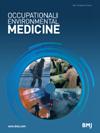2003-2021 年澳大利亚维多利亚州因火灾和烟雾造成的职业伤害:描述性研究
IF 3.9
2区 医学
Q1 PUBLIC, ENVIRONMENTAL & OCCUPATIONAL HEALTH
引用次数: 0
摘要
目标 因火灾、火焰或烟雾而入院就诊通常与工作有关。本研究旨在探讨澳大利亚维多利亚州与工作有关的火灾/火焰/烟雾伤害的时间趋势和风险因素。方法 本研究基于 2003-2021 年维多利亚州急诊最低数据集的急诊科 (ED) 就诊记录。根据编码数据和/或叙述,如果受伤原因被记录为火灾/火焰/烟雾,则病例为 15-74 岁与受伤相关的急诊室就诊者。与工作相关的比率按就业人口计算;与工作无关的比率按人口计算。使用逻辑回归模型对与工作相关和非工作相关的病例进行比较。结果 与火灾/火焰/烟雾有关的急诊室就诊人数为 11 838 人,其中 1864 人(15.7%)与工作有关。与工作无关的急诊就诊率为每 10 万人 12.3 例,而与工作有关的急诊就诊率为每 10 万就业人员每年 3.43 例。在研究期间,与工作相关的发病率每年下降 2.0%(p<0.0001),而非工作相关的发病率每年上升 1.1%(p<0.0001)。与工作有关的病例(与非工作有关的病例)与夏季(与冬季)有关,但与极端丛林火灾时期(维多利亚州的 "黑色星期六 "和 "黑色夏季")的关联在统计学上并不显著。从分流情况和随后的入院情况来看,与工作有关的病例比与工作无关的病例严重程度要低。结论 在过去二十年中,维多利亚州与火灾/火焰/烟雾有关的职业伤害发病率有所下降,而与工作无关的发病率则有所上升。这可能反映出工作场所的安全状况有所改善。不过,医院数据无法用于区分职业或行业,因此建议开展就业数据关联研究,以进一步了解工作场所的预防措施。数据可能来自第三方,不对外公开。本文章由计算机程序翻译,如有差异,请以英文原文为准。
Occupational injuries caused by fire and smoke in Victoria, Australia, 2003–2021: a descriptive study
Objectives Hospital attendance related to fire, flame or smoke exposure is commonly associated with work. The aim of this study was to examine time trends and risk factors for work-related fire/flame/smoke injuries in Victoria, Australia. Methods This study was based on emergency department (ED) presentation records from the Victorian Emergency Minimum Dataset, 2003–2021. Cases were people aged 15–74 years with injury-related ED presentations, if cause of injury was recorded as fire/flame/smoke, based on coded data and/or narratives. Work-related rates were calculated per employed persons; non-work rates were calculated per population. Work-related and non-work-related cases were compared using logistic regression modelling. Results There were 11 838 ED presentations related to fire/flame/smoke: 1864 (15.7%) were work-related. Non-work-related rates were 12.3 ED presentations per 100 000 population , and work-related rates were 3.43 per 100 000 employed persons annually. Over the study period, work-related rates decreased annually by 2.0% (p<0.0001), while non-work rates increased by 1.1% (p<0.0001). Work-related cases (vs non-work) were associated with summer (vs winter), but the association with extreme bushfire periods (Victorian ‘Black Saturday’ and ‘Black Summer’) was not statistically significant. Work-related cases were less severe than non-work-related cases, evidenced by triage status and subsequent admission. Conclusions Rates of occupational fire/flame/smoke-related injury presentations decreased over the past two decades in Victoria, while non-work-related rates increased. This could reflect improved safety in the workplace. Hospital data, however, cannot be used to distinguish occupation or industry therefore, employment data linkage studies are recommended to further inform workplace preventive measures. Data may be obtained from a third party and are not publicly available.
求助全文
通过发布文献求助,成功后即可免费获取论文全文。
去求助
来源期刊

Occupational and Environmental Medicine
医学-公共卫生、环境卫生与职业卫生
CiteScore
8.30
自引率
2.00%
发文量
98
审稿时长
2 months
期刊介绍:
Occupational and Environmental Medicine is an international peer reviewed journal covering current developments in occupational and environmental health worldwide. Occupational and Environmental Medicine publishes high-quality research relating to the full range of chemical, physical, ergonomic, biological and psychosocial hazards in the workplace and to environmental contaminants and their health effects. The journal welcomes research aimed at improving the evidence-based practice of occupational and environmental research; including the development and application of novel biological and statistical techniques in addition to evaluation of interventions in controlling occupational and environmental risks.
 求助内容:
求助内容: 应助结果提醒方式:
应助结果提醒方式:


